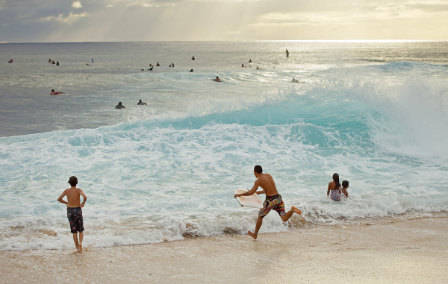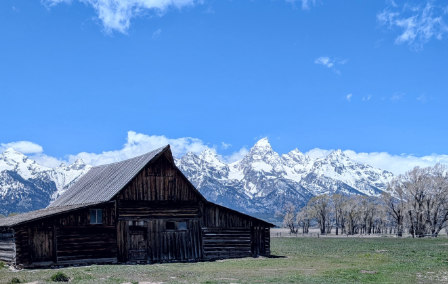Published 17th Jul. 2023
Reading time
While city living has its own advantages, there’s no denying that the star-studded skies of the suburbs possess a certain type of magic. Increasingly, travellers are seeking out the reflective calm of the night sky and the phrase ‘astrotourism’ has come to define these star-chasing experiences. Chile has long championed such encounters, with laws in place to prevent light pollution and maintain dark sky sites. So it comes as no surprise that the USA has decided to get in on the action with its expansive landscapes and out-of-this-world celestial sites. In fact, some of the continent’s national parks have been named International Dark Sky Parks, in recognition of their minimal light pollution and inky black heavens. Feeling inspired for your next USA trip? Immerse yourself in the meditative state of gazing up at a light-pricked tapestry with our selection of the best stargazing in the USA...
Spanning a whopping 800,000 acres, it’s unsurprising that much of Big Bend National Park remains unchartered territory, occupied only by coyotes, roadrunners and javelinas (pig-like mammals that resemble wild boars). Moreover, the park’s remote location – near the Mexican border in southwest Texas – means it’s one of the USA’s least visited national parks. This isolation and solitude set it up perfectly as a stargazing site. And with little-to-no light pollution, it’s no surprise that Big Bend has made it as an International Dark Sky Park. Take in the hauntingly beautiful scenery by day and enjoy uninterrupted celestial activity come night.
Calling all avid geographers. The hydrothermal sites, jagged peaks and steaming fumaroles are the obvious showstoppers of this northern Californian national park. In fact, all four types of volcanoes (shield, composite, cinder cone and plug dome) can be found in the park so it certainly lives up to its volcanic name. A network of glittering lakes and hiking trails criss-cross Lassen’s landscape, allowing visitors to sift through the treasure trove of geological wonders, including bubbling mud pots and lava rock-littered terrain. And as night falls, the park offers some of the best stargazing in the USA, with Starry Night ranger-led programme and moonlight hiking trails up for grabs.
As its name suggests, Canyonlands National Park in Utah preserves a striking landscape of steep-sided canyons, mesas and buttes, carved out by the Colorado and Green Rivers. The park is divided into four distinct districts (the Island in the Sky, the Needles, the Maze and the two rivers), which share a desert atmosphere but differ in terms of their fascinating geological features. Along with this otherworldly topography, Canyonlands boasts one of America’s darkest skies, earning itself the accolade of Gold-Tier International Dark Sky Park. The naked eye alone is enough to witness the wealth of stars that hover above.
While Rappahannock is classified as a county park (rather than a national park) its status as a stargazing site shouldn’t be underestimated. Situated at the entrance to Virginia’s Blue Ridge Mountains, with the famed Appalachian Trail within close proximity, the humble county park has been recognised as an International Dark Sky Park and is home to some of the best stargazing in the USA. Most notably, Rappahannock is one of only a handful of places on the East Coast where the Milky Way can clearly be seen shimmering overhead.
Last but by no means least on our list of the best stargazing in the USA is Voyageurs National Park, located close to the Canadian border in Northern Minnesota. Blessed with naturally low light pollution, the park has plenty of dark sky areas, which allow unobstructed views of the night sky’s constellations. To add to the magic, more than a third of the park’s 218,000 acres is made up of miles of interconnected waterways; floating down one of the tributaries by boat takes stargazing to a whole new level.
Written by Luisa Watts

From New York to California and all the states in between, our team knows the USA's hotspots incredibly well. What we really excel at, though, is the under-the-radar regions, thanks to our in-depth experience and the hand-picked guides we work with on the ground. Whether you’re travelling as a family or à deux, road trips are the ultimate way to explore the USA, and we're brimming with suggestions to improve journeys, from scenic route options to photogenic stop-off points (all based on our own experiences, of course). And if that's not enough, you'll have our in-country Concierge team on hand at all times for extra help and advice.
ENQUIRE NOWPractical advice and inspiration for your next trip

Spring in New York is an underrated sweet spot. While the Big Apple typically tempts travellers with its magical winters and sizzling summers, spring promises the gift of crowd-free fun. As the weather begins to warm, coats and winter blues are shed, cherry blossoms explode to life and rooftop bars reopen. Tick off the city’s classic corners (hello, Times Square) and join in with the seasonal festivities.
30th September 2025 - USA Guide

When it comes to postcard-perfect beaches, the USA has them in bucket-(and spade)-load. From California’s colourful coast and Florida’s buzzing beaches to Oregon’s rugged shores and Georgia’s photogenic stretches, there’s no shortage of sandy escapes on a USA holiday. Spot puffins on Cannon Beach and nesting turtles on Perdido Key, or stroll past Art Deco architecture on South Beach and charming hotels overlooking Coronado Beach.
4th August 2025 - USA Beaches & Islands

Americans know a thing or two about wide, open spaces, and our USA specialist, Dave, discovered what all the fuss was about during his research trip to the Rockies and the American West. He dug into dinosaur discoveries in Bozeman, snapped pictures of Yellowstone’s Grand Canyon and spotted bears and bison in Grand Teton National Park. When he wasn’t cheering at a Major League Baseball game in Denver, he was tucking into South Dakota’s specialty steak dish.
15th July 2025 - USA Travel Tips

Our team of destination experts will get to know you and your unique requirements for your holiday

We work with you to build an ultra-personalised holiday itinerary with your choice of accommodation, experiences and activities

All of our holidays include little extras designed to make a big difference to your trip, from fast-tracking you through airport check-in and security to our network of local Concierges